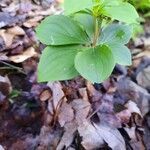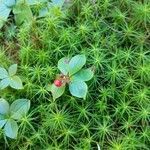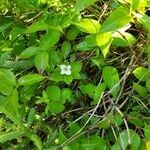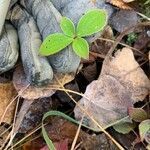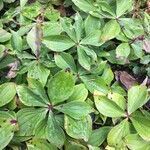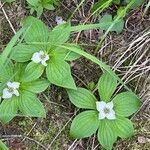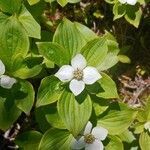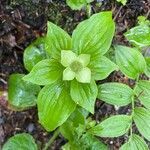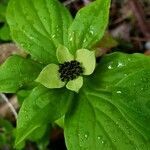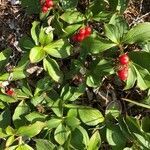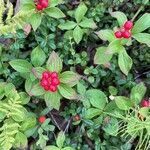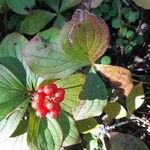Herblike shrubs, perennial, rhizomatous, 10–20 cm tall. Rhizomes creeping, slender. Vertical stems slender, unbranched. Leaves opposite, often appearing as a whorl of 6 at terminal node due to compression of internodes, 2 larger and 4 smaller; smaller ones developing from axillary buds of larger leaves; leaves at lower nodes rudimentary; petiole 2–3 mm; leaf blade obovate to ± diamond-shaped, 3.5–4.8 × 1.5–2.5 cm, papery, veins 2 or 3, base cuneate, margin entire, apex shortly acuminate. Inflorescences compound cymes, terminal; bracts white, broadly ovate, 0.8–1.2 × 0.5–1.1 cm, with 7 parallel veins. Flowers white, ca. 2 mm in diam. Calyx tube obovate, ca. 1 mm, densely pubescent with grayish white appressed trichomes; teeth higher than disk. Petals reflexed, creamy white, ovate-lanceolate, 1.5–2 mm. Stamens ca. 1 mm; anthers yellowish white, narrowly ovoid. Style ca. 1 mm, glabrous. Fruit red at maturity, globose, ca. 5 mm in diam.; stones ellipsoid-ovoid. Fl. Jul–Aug, fr. Aug–Sep.
Shrub 1–5 m, often forming thickets; twigs glabrous, at first green, soon becoming tan and eventually gray-brown; old bark mostly smooth and gray; pith white (tan); lvs lanceolate to elliptic, mostly 4–8 cm, a third to half as wide, abruptly acuminate, cuneate at base, often papillose-whitened beneath, sparsely strigose to glabrous on both sides, with 3 or 4(5) lateral veins to a side; infls often very numerous, convex to often pyramidal and paniculiform; fr at first leaden, becoming white (light blue), 5–8 mm, on reddish pedicels; 2n=22. Moist soil, woods, thickets, roadsides, and streambanks; Me. and s. Que. to s. Man., s. to Va., s. Ill., and Mo., adjoining but only slightly overlapping the range of no. 6 [Cornus stricta Lam.]; the two might well be considered vars. of one sp. (C. paniculata; ? C. foemina, a doubtful name)
A herb which keeps growing from year to year. It is deciduous and low and spreading. It grows 10-20 cm tall. The rhizomes are creeping and slender. The leaves are in rings and are 25 mm long and oval or sword shaped. The leaves turn red in autumn. There are white bracts around the flower-heads. The flowers are silvery white. The fruit are small, bright red berries.
